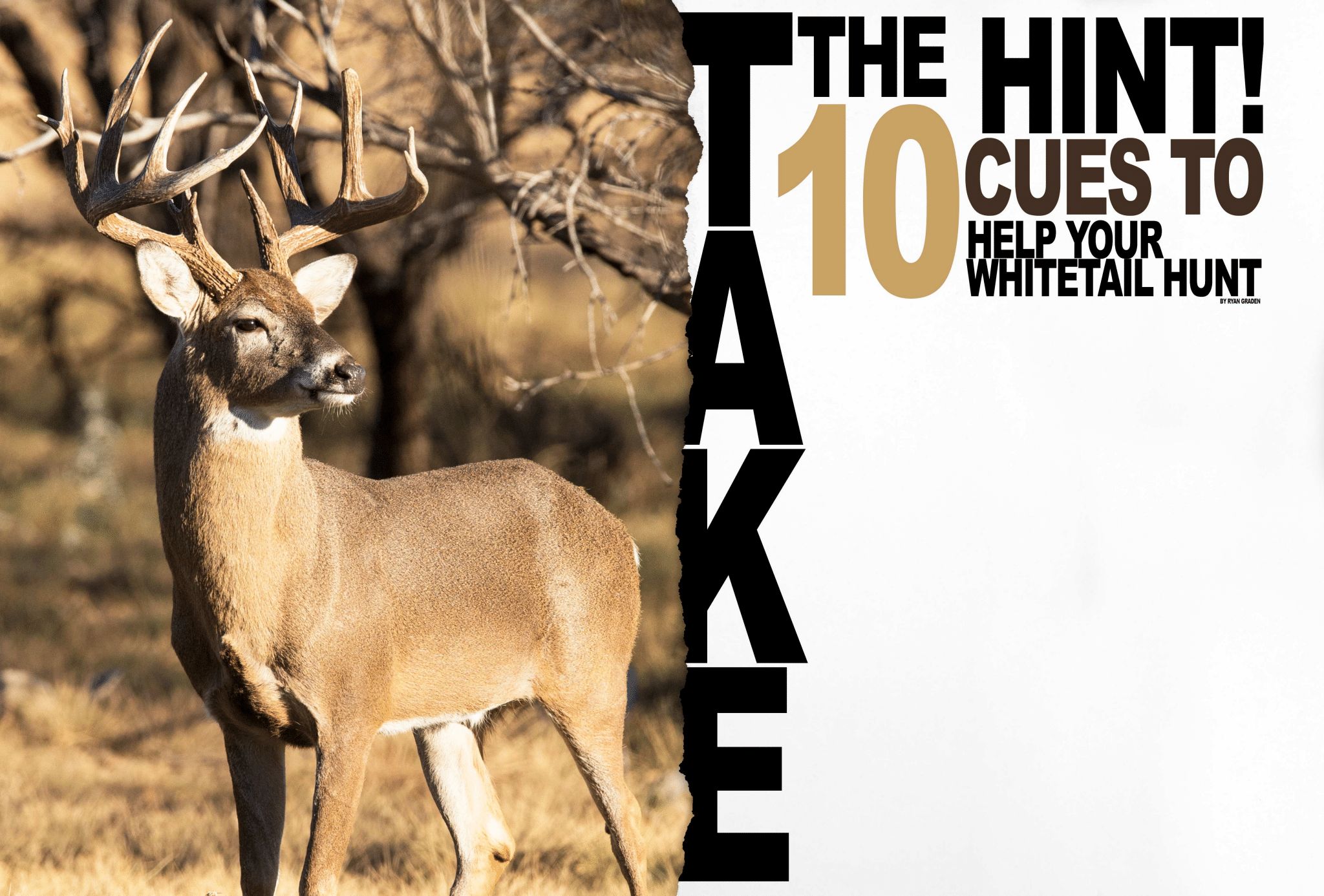Deer Cues to Look For

Deer Cues to Look For
Everybody likes a good hint when they need it right? Remember back in your schooldays when the teacher said, “I’ll give you a hint?” When I heard that phrase, I would zero in to what she was going to say next. I did not want to miss anything that might help me with the challenge set before me.
The same goes for hunting whitetails. The challenge is the hunt. The cues and hints that can lead you to a successful hunt are invaluable. If you are a new hunter or a seasoned veteran, there’s always a few more things to learn that might give you an advantage in the timber.
So follow along! Maybe some of the following “cues” might become a useful bit of information to have in your pocket for the upcoming hunting season.
Cue #1 – Get the Right Habitat
Deer are versatile creatures. If you look at the terrain of our country, whitetails can survive in a variety of ecosystems. Here in the Midwest, it’s very much the same. I’ve known deer to make their homes very far from any cover of timber and be just fine. However, there are some basic needs that whitetails have to have in order to survive.
There are three necessary things to look for. Water, food, and cover. Find all three of these things and you will most likely be seeing deer.
Water will consist of ponds, streams, rivers, or lakes. Next, look for nearby food sources. Timbers full of acorns and a good variety of undergrowth greens. Prairies with nearby corn and soybean fields. For cover, a grove of cedar trees, underbrush in the timber, fallen timbers, or tall prairie grass CRP fields.
Cue #2 – Realize the Patterns
Deer are pretty consistent in their daily routines. Just like some of us are, they go to sleep and wake up at about the same time. They use the same food sources and water sources. They use the same general areas to bed. In addition, they will often use the same few travel corridors to get where they want to go.
A hunter looking for success needs to do a little homework in this area. Especially if they are looking for a particular deer. Get out on the property you plan to hunt and figure things out.
However, let me throw a “curveball” into this cue. This all works pretty well until the rut begins to happen. At that point, patterns become less predictable for that month or so of breeding. Still, the deer will be in the areas they call home. You will still see them, but they will be less predictable. However, they will be moving more throughout the daytime hours which is not always the case.
Spend your time in the stand or blind and you’ll have success in November.
Cue #3 – Befriend Your Weather App
I can’t stress this enough. Know your weather!
Deer will be up and around in all sorts of weather. Like humans, the favor nicer weather and you might see them more often when it is agreeable out. However, they don’t “lock down” when weather is not so peachy. You can hunt deer in a variety of types of weather. It can be done. However, different types of weather might dictate where you SHOULD hunt in order to have success.
Wind can be your worst enemy or your best friend during a hunt. Deer have an incredible sense of smell and if they catch wind of you, you might as well turn around and walk away! I know that there are all kinds of scent eliminating clothing and mechanical items out there to, supposedly, take away your human scent. But, here’s my theory, if you’re breathing, you stink!
Use the wind to your favor every chance that you get. Make sure your quarry is upwind of you. If the wind is in question for a particular spot you want to hunt, don’t force it! Take the night off or go somewhere else. Deer will remember things and you just might ruin a great stand by taking a risk like that.
Cue #4 – Find the Perfect Place
You have to get close enough to make the shot. Let’s make it plain here. If you aren’t close enough for a shot, you’ll never get a shot.
Proper placing of your stand or your blind is key to having success! This also has a bit to do with cue #2. If you know where your deer are bedding, traveling, or eating, you can make some great decisions on where to create your place of ambush.
Always make sure that your stand or blind is downwind of where the deer will be. Obviously, the wind might change from day to day. Make note of the most common wind direction for that area and place your stand accordingly.
Make sure you are high enough that your are out of sight. Leave some cover in the branches and on the ground below. The whole point of camo is to “blend in” to your surroundings. If you cut out all your surroundings, you’ve just eliminated your ability to hide. Trim out your “shooting lanes” but don’t cut down all the undergrowth below you.
Cue #5 – Speak the Language
Calling deer can be a useful tool for your hunt. Especially during the rut or breeding season that happens the month of November.
There are three calls that I use on regular basis during this time. The doe bleat, buck grunt, and the snort-wheeze.
Many hunting brands make these calls and they are very easy to use. Personally, I use one of the “cans” for my doe bleats. I simply tip that can up and down to create doe bleat that echoes through the timber. It takes very little movement and the sound is very effective! When that call goes out through the woods, rutting bucks will come a running!
Using a grunt call is great for challenging a distant buck. Whether you can see him or not. A grunt call is yet another way to draw that buck closer allowing you to get a shot.
A snort-wheeze call can be made with your mouth if you learn the pattern and sound of it. You can also buy calls that are out on the market to help you make the proper sound. Use a snort-wheeze when you have a buck that doesn’t seem interested in either your doe bleat or grunt. The snort-wheeze will sometimes be that call that turns him on a dime and brings him in ready to rumble.
Cue #6 – Know the Warning Signs
Deer also speak another language that would be helpful for you to know if you are in the woods pursuing them. These are the signs and sound that will tell you, “I’m about to leave.” Which translates into us saying, “If I have the shot, I’d better take it soon!”
There are two characteristic sounds that you should look for and listen for when you are in your stand. They are the “stomp” and the “blow”.
When deer are suspicious of something they will begin to stomp with their front feet. Sometimes they will use the same foot over and over again. Sometimes they will alternate. Their posture will be alert, head up, ears forward, and they will be looking for whatever they are suspicious of. Stomping will go on for seconds or even minutes. However, you can bet, their next move is going to be a retreat from the area.
The blow sound will be a loud exhale through their nose. And believe me when I say, it’s loud! Deer use this sound to notify all the other deer in the area that danger is nearby. Deer will often blow and the next second, run. They might run a great distance or just a few large bounds away. If you hear this, know that you have about ½ second before they run.
Cue #7 – Where to Look After a Marginal Shot
Sometimes, as hunters, we won’t always make the best shot. Maybe we have an excuse. A branch moved when the wind blew. The deer dropped lower than we expected during the shot. Maybe they took an unexpected step. Sometimes, we get too excited and make a poor decision to take a shot that isn’t at a good angle. Whatever the case, you own it to the deer to track them until you find them or there is no longer sign to follow.
Here’s a few tips or cues to help you figure out where they might go.
When deer are wounded and bleeding (slowly), they will often begin to feel very thirsty. This thirst will become overwhelming for them. Their solution will be to go to a water source. Knowing your property, I would begin to key into streams, ponds, rivers, and lakes.
Over the years, I’ve made a few of these marginal shots. On one occasion I found a doe I had wounded laying in a stream the following morning after tracking her about a half mile. You could see that she had bedded right near the stream. On another hunt, I had a buck run to the edge of a nearby river. I was able to track a small amount of blood to the edge of the river where I then saw him slowly floating away! Both mortally wounded. Both went to water.
The other tip would be look for paths of least resistance and paths of ease. When deer are wounded, they are looking for protection and cover. When suffering from pain, they may not jump fences, or barriers. They may not go through brush. However, they WILL follow established trails, roadbeds, and even roads. They are more likely to travel down a hill rather than up. Look in the lower areas of your property for your deer if this happens.
Cue #8. – If it’s Cold, You Need to Hunt!
If you a true Midwesterner, our winters won’t hinder you a bit. If you’re hunting the Iowa winters or have in the past, you will also realize that the cold weather can be your best advantage to filling your tag.
Here in Iowa, we are talking about the shotgun seasons, late muzzleloader seasons, and even the bow season if you did not fill your tag earlier during the rut.
The cold will drive deer to feed. The colder it is, the more they are on their feed searching for the food they need. Calories are key to survival during the Iowa winters. In order to keep their core temperatures warm enough to survive, deer have to feed and take it larger amounts of food the colder it gets.
If you are seeing extreme temperatures in the forecast, make plans to hunt near some key food sources. Food plots, fields, or even oak trees that have dropped a good number of acorns. All would be attracting deer if the frigid temperatures hit.
Cue #9 – Predict Your Shot
Every time I get into a stand, I take the next few moments to scan the scene before me. I take notice of the trails, the wind direction, and any other tid-bits of information that might be helpful.
Then I begin to plan my shot opportunities. If I’ve done my homework, I should know where to expect deer to appear. How far away they might be. What direction they might come from and where they be going to. I pick shooting lanes that will be best for taking possible shots. Making sure I make note of “points of no return” which are areas that are no longer good for a shot.
I even take another step in this process by “playing through” the possible event of the hunt. Looking at the chest, not the antlers. Taking slow breaths. Relaxing and settling into my shot. Slowly squeezing the trigger. (Gun or bow)
Mentally preparing yourself in this way will allow you to go on “auto drive” when the opportunity appears.
Cue #10 – Stay in Tune!
Spending hours in the stand can become boring! Maybe some of you out there don’t mind it, but for some, it drives you nuts.
You have to have your senses awake and alert. Pay attention to everything that you see, hear, feel, smell, and touch. All of these will give you cues when something is coming. If you ignore the cues, you just might miss the buck of a lifetime!
A few years ago I was after a particular buck. 27 days straight I hunted for this buck. One evening I chose a stand that was near his general bedding area. The stand was in a large white oak tree.
The hours waned and the sun began to set. I saw squirrel after squirrel digging through the crust of snow to get their last bites of food for the day. It became dull and I quit turning my head at every crunching sound I heard.
With about 10 minutes left to hunt, another “squirrel” began to make noise behind my tree. I ignored it. A few more minutes ticked by and the sound ended to my left. At a glance, I noticed the buck that I had been chasing standing calmly to my left. He had already passed my two chosen shooting lanes. I had to stretch my shot up over an oak branch.
I squeezed the trigger and was fortunate enough to watch my lighted knock zip through his chest and stick in the ground. A short 10 seconds of chaotic noise led to a final crash and the trophy I had been pursuing. I got lucky. But ignoring my senses almost cost me an empty tag!
As you hunt, you will learn more and more about the sport of chasing whitetails. Always make sure that you are putting these “tips and cues” into your hunting bag of tricks. As you gather more of them, you will continue to gain a confidence that will enable you to hunt in many situations.
Use them or leave them. It’s your choice. These are the cues that I use often and have worked for me during many of my hunts. I’m sure there are more to come, but until then, good luck!
by Ryan Graden
August 2020
Check Out this Article on Tips for During the Rut –


